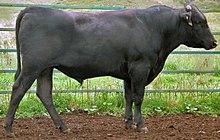| Revision as of 10:11, 18 November 2011 editPhoenix7777 (talk | contribs)Extended confirmed users14,567 edits changed wagyū to wagyu per successful requested move.← Previous edit | Revision as of 13:28, 7 December 2011 edit undoRipchip Bot (talk | contribs)35,574 editsm r2.7.1) (Robot: Modifying ar:واغيوNext edit → | ||
| Line 48: | Line 48: | ||
| {{DEFAULTSORT:Wagyu}} | {{DEFAULTSORT:Wagyu}} | ||
| ] | ] | ||
| ] | ] | ||
| ] | ] | ||
Revision as of 13:28, 7 December 2011



Wagyu (和牛, Wagyū, literally Japanese cow) refers to several breeds of cattle genetically predisposed to intense marbling and to producing a high percentage of oleaginous unsaturated fat. The meat from wagyu cattle is known worldwide for its marbling characteristics, increased eating quality through a naturally enhanced flavor, tenderness and juiciness, and a high market value. In several areas of Japan, beef is shipped with area names. Some examples are Kobe, Mishima, Matsusaka, Ōmi beef and Sanda beef. Highly prized for their rich flavor, these cattle produce arguably the finest beef in the world. These different breeds produce beef that range from expensive (by any measure) to extremely expensive (about US$50 per 150 grams of filet steak sold retail in Japan).
Wagyu cattle's genetic predisposition yields a beef that contains a higher percentage of omega-3 and omega-6 fatty acids than typical beef. The increased marbling also improves the ratio of monounsaturated fats to saturated fats.
History
Japan
By order of the Shogun, the cattle herd in Japan was closed and eating meat from any four-legged animal was prohibited from 1635 to 1838. Because of Japan's rugged terrain and isolated areas, different breeding and feeding techniques were used such as massaging or adding beer or sake to their feeding regimen. It is suggested that this was done to aid in digestion and induce hunger during humid seasons, but it appears to have no effect on the meat's flavor. Massaging may have been introduced to prevent muscle cramping on small farms in Japan where the animals did not have sufficient room to use their muscles.
There are four major breeds of wagyu: Japanese Black (黒毛和種, Kuroge washu), Japanese Brown (赤毛和種, Akage Washu), Japanese Polled (無角和種, Mukaku Washu), and Japanese Shorthorn (日本短角和種, Nihon Tankaku Washu). Japanese breed names include Tajima, Hida (Gifu Pref.), Tottori, Shimane, Kochi and Kumamoto. Kumamoto Prefecture is famous for its red wagyu cattle. The more famous black variety has its origins in Kobe.
Australia
The Australian Wagyu Association is the largest breed association outside Japan. Both Fullblood and Wagyu cross cattle are farmed in Australia for domestic and overseas markets, including Taiwan, China, Hong Kong, Singapore, Indonesia, the U.K., France, Germany, Denmark and the U.S.A.
Australian Wagyu cattle are grain fed for the last 300–500 days of production. Wagyu bred in Western Australia's Margaret River region often have red wine added to their feed as well. Although less than 100,000 of the 28.8 million head of cattle in Australia are Wagyu or Wagyu infused, the long-feed nature of Wagyu production takes up 40% of Australian feedlot space in any given 12-month period.
United States
In the United States, Japanese wagyu cattle were bred with Angus cattle to create a crossbred animal that would be more able to survive the U.S. climate and ranching methods. The meat of this crossbreed was more marketable to the typical American buyer, for whom the meat of the Wagyu cow is "too white." The meat of the crossbreed provides the balance of marbling and red meat desired by them. This crossbreed has been named American Style Kobe Beef.
Designed to mimic the diet that Japanese cattle were receiving, wagyu cattle in the United States are fed a mixture of corn, alfalfa, barley and wheat straw.
As of 2007, the U.S. cannot ship wagyu beef to Japan, as Japan requires that beef imported from the U.S. be from cattle not older than 20 months; U.S. wagyu cattle are usually slaughtered at 30–35 months.
References
- Condon, John (2005-03). "Good Fats Boost Wagyu Opportunities". Australian Wagyu Update. Archived from the original on 2007-08-29. Retrieved 2006-12-07.
{{cite news}}: Check date values in:|date=(help) - "Wagyu Beef History". Kobe-beef.com. 1998-03-22. Retrieved 2009-05-10.
- Porter, Valerie; Mason, Ian Lauder (2002). Mason's world dictionary of livestock breeds, types, and varieties. CABI. p. 66. ISBN 085199430X.
- According to the Australian Wagyu Association: http://wagyu.org.au/index.php?option=com_content&task=view&id=13&Itemid=64
- MSNBC http://www.msnbc.msn.com/id/10642546/. Retrieved 13 July 2010.
{{cite news}}: Missing or empty|title=(help) - Associated Press, "U.S. ranches breed famous Kobe-style beef", Japan Times, 12 August 2011, p. 3.
- http://www.wagyu.org/JapanLabeling01.doc
External links
- American Wagyu Association
- Australian Wagyu Association
- Canadian Wagyu Association
- European Wagyu Association
- German Wagyu Association
- Wagyu Research and Information Department of Animal Sciences, Washington State University
- "Breeding History of Japanese Beef Cattle...", Professor Kiyoshi Namikawa, Department of Animal Sciences, Kyoto University - Kyoto, Japan, circa 1985